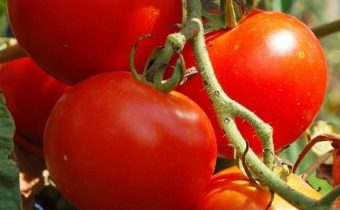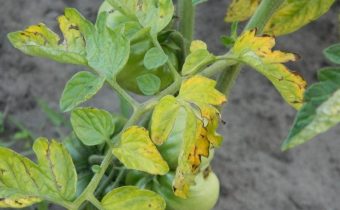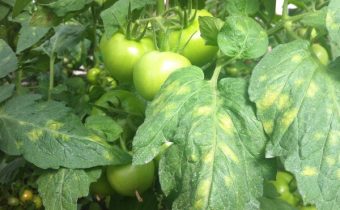Diseases of tomatoes in the greenhouse and their treatment
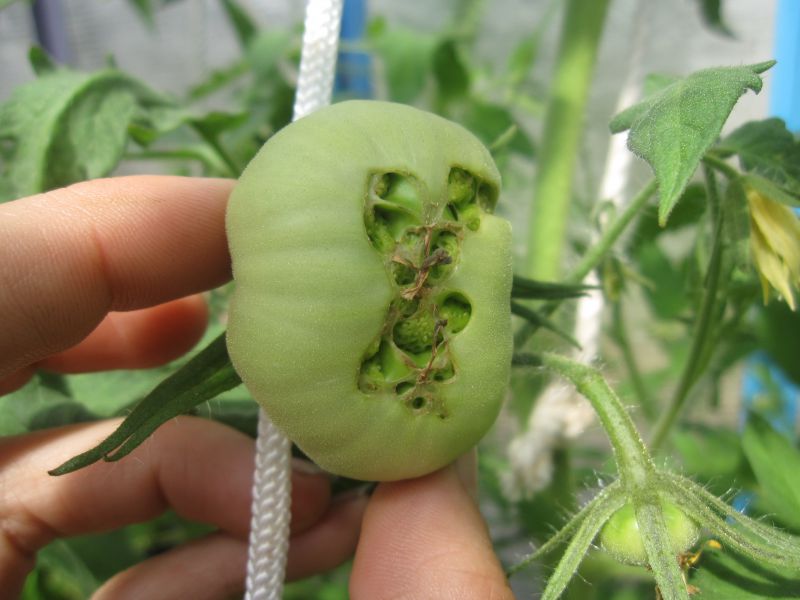
Unfortunately, sometimes moving away from some problems, we reluctantly acquire others. In order for the diseases of tomatoes in the greenhouse and the greenhouse not to take us by surprise, it is necessary to understand them.
Considering the diseases of tomatoes in the greenhouse, photos, and their treatment, you need a clear idea of the causes of their occurrence. But, whatever the reason, since the disease has arisen it is necessary to treat it. But so that the disease does not arise, it is necessary to foresee and carry out in advance a number of activities that will help prevent the occurrence of a disease of tomatoes in the greenhouse.
Diseases of tomato seedlings and their treatment
Growing a tomato in a greenhouse, it is not always possible to correctly adjust the temperature, humidity, air velocity. Imbalances in the mode of cultivation can most often lead to such diseases of seedlings:
- Blackleg. Fungal disease. The root neck of seedlings is affected. The stem is covered with black bloom, thinning, the plant dies. The seedlings that remain, develops poorly. Sick plants are removed, the remaining, watered with a solution of manganic acid potassium in a concentration of 0.1 g per liter of water;
- Alternaria, dry or black spot tomato. The first signs are noticeable on the lower leaves, then brown dry spots increase and pass to the stems and leaves of the upper tiers. With increased humidity, a velvety gray "down" is visible on the affected areas. The fungus develops particularly well at high daytime and low night temperatures with little air movement. Treatment with drugs: "Acrobat MC", "Tanos 50", "Metaxil", "Kvadris 250 SC" with greenhouses airing quickly enough cope with the fungal disease;
- Southern tomato late blight. The signs are very similar to the black leg, but this mushroom forms a constriction on the seedling leg and damages the root system, therefore the whole plant fades. The drug "Pseudobacterin-2" quickly kills the fungus;
- Septoria, macroscopic infections, white spotting and manifests as off-white spots with brownish edges on the lower sheets of tomato seedlings with a transition to the top. Abundant spread of pathogenic fungus begins at a temperature of 20-22 and humidity close to 100%. Treatment with drugs "Thanos 50", "Revus 250 SC.C.S" not only restrain, but also eliminate the harmful fungus.
See also:Tomato "Gina". Characteristics and description of the variety
Diseases of tomatoes in the greenhouse and their treatment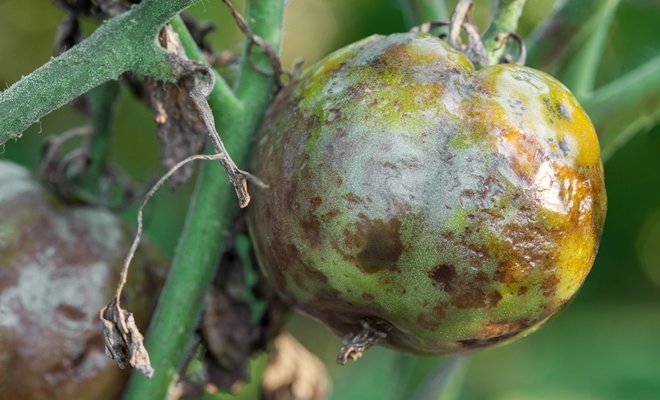
Even if the seedlings are successfully grown, it still does not guarantee a healthy and bountiful harvest. Diseases trap a tomato in a greenhouse at any stage of the growing season.
Fungal diseases
- Alternaria infection of an adult plant is similar to a seedling, with the same methods of control;
- Cladosporiosis or leaf mold. Yellow, multiple spots, turning into brown, followed by abscission of foliage. The plants are completely left without foliage, the fruits begin to ripen rapidly in an underdeveloped form. The fungus can preserve its virulence in the greenhouse for more than 10 years, it can withstand both drying and freezing. Preparations "Pseudobacterin-2", "Fitosprin-M", "Poliram", "Abiga-Peak", "HOM" quickly and efficiently cope with the disease agent;
- Ascochitis or cancer of tomato or didimela stems. The mushroom has chosen both film and glass greenhouses.The affected stalk has brown depressed spots with sweating “gum”. Among the biological preparations "Trichodermin", as well as apply "Poliram" and "Rovral";
- Anthracnose. On the fruit spots appear dents, first the colors of the fruit, then they darken, and the fruits are mummified. Spraying with the preparations “Novosil”, “Agat”, “Kadris”, “Strobe” are quite effective;
- Mealy dew. The disease is caused by several mushrooms. Mealy plaque leads to chlorosis of the leaves with the transition to necrosis. Preparations "Baktofit", "Kvadris", "Bayleton", "Topaz" perfectly cope with the disease, especially at an early stage of development.
See also:Tomato "Explosion" reviews photos who planted?
Bacterial diseases
- Bacterial black spot tomato. Spot, small, watery spots on all vegetative organs of the plant. Particularly dangerous is the defeat of the pedicel, which leads to the complete dropping of flowers. Black spots with a rim are formed on the fruits. “Baktofit”, “Fitosporin-M”, “Planriz”, “Khom” have confirmed their effectiveness for a long time;
- Bacterial wilt. With extensive fading, Fitolavin-300 is used.
- Bacterial cancer of tomatoes. When the first symptoms are detected: leaf lobes fade unilaterally, as a rule, from the lesion of the vascular system, which can be clearly seen when the stem is cut, the plants are immediately treated with Fitosporin-M and Fitolavin-300
See also:Tomato "Rocket", reviews, photos, who planted?
Viral diseases
- Tomato aspermia. With the defeat of the virus commodity tomato does not ripen. Axillary shoots do not develop, the bush becomes "shaggy", the leaves are deformed, pink-lilac color. The virus is transmitted mechanically.
Having built a greenhouse and planted tomato seedlings, you need to inspect the plantings very carefully every day. Diseases of tomatoes and the fight against them are not always simple and end favorably. In order to prevent the occurrence of diseases, it is necessary to strictly adhere to the rules of tomato agrotechnology in protected ground, because to prevent the disease is much easier than to make the correct diagnosis and successfully assist.


